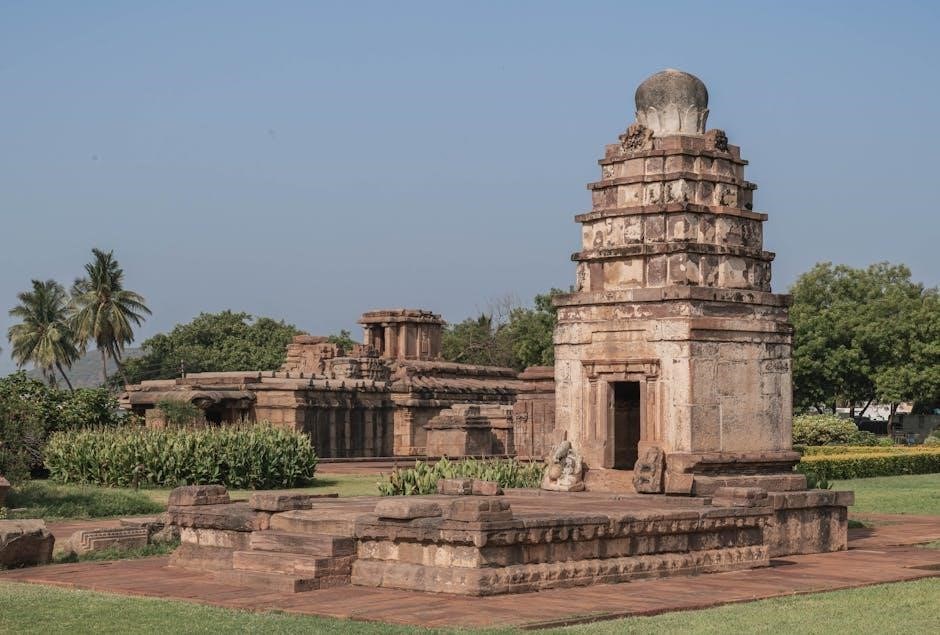Cultural landscapes represent the transformation of natural environments by human activity, reflecting cultural, social, and historical contexts. They embody the interaction between nature and humanity, creating unique systems that define regions and communities. These landscapes are essential for understanding human adaptation and cultural identity.
1.1 Definition and Concept
The cultural landscape is a concept in human geography that describes the visible and tangible expression of human interaction with the natural environment. It encompasses the physical modifications made to the Earth’s surface by human activities, reflecting cultural, social, and historical contexts. Carl Sauer, a prominent geographer, defined the cultural landscape as the “area of Earth modified by human habitation,” emphasizing the role of culture in shaping the environment. This concept highlights the dynamic relationship between nature and humanity, where landscapes are not just physical spaces but also repositories of cultural identity and memory.
Cultural landscapes are composed of both natural and anthropogenic layers, blending elements such as agricultural fields, urban structures, and religious sites. They are dynamic, evolving over time as societies change and new technologies emerge. The study of cultural landscapes provides insights into how human values, beliefs, and practices shape the world around us. By examining these landscapes, geographers and scholars can uncover the historical and cultural processes that have transformed natural environments into meaningful human spaces.
Key theorists like James M. Rubenstein have further developed this concept, exploring how cultural landscapes reflect global and local interactions. UNESCO has also recognized the importance of cultural landscapes, designating sites like the Konso Cultural Landscape in Ethiopia and Bam in Iran as World Heritage Sites. These examples illustrate the significance of preserving cultural landscapes as living records of human history and identity.
1.2 Historical Background
The concept of cultural landscapes has evolved significantly over time, with its roots tracing back to early geographical studies. Carl Sauer, a pivotal figure in the development of cultural geography, defined the cultural landscape in the early 20th century as “the area of Earth modified by human habitation.” His work laid the foundation for understanding how human activities shape the environment, blending natural and anthropogenic elements. Before Sauer, geographers and thinkers had explored similar ideas, but his formalization brought clarity and focus to the field.
Historically, cultural landscapes have been shaped by human adaptation to natural conditions, technological advancements, and societal values. The Industrial Revolution, for instance, profoundly altered landscapes through urbanization and mechanized agriculture. Globalization further influenced these changes, leading to both cultural homogenization and hybridization. These shifts have been documented by scholars like James M. Rubenstein, who explored the interplay between global and local forces in shaping landscapes.
UNESCO’s recognition of cultural landscapes as heritage sites emerged in the late 20th century, highlighting their importance as living records of human history. This recognition emphasized the need to preserve these areas, acknowledging their cultural and historical significance. The evolution of the concept underscores the dynamic nature of cultural landscapes, reflecting humanity’s ongoing interaction with the environment.
Key Theorists and Their Contributions
Carl Sauer and James M. Rubenstein are central figures in shaping the concept of cultural landscapes. Sauer’s foundational work defined the term, while Rubenstein expanded on its applications, providing frameworks for understanding human-environment interactions and cultural influences on land use.
2.1 Carl Sauer’s Work
Carl Sauer, a prominent geographer, introduced the concept of the cultural landscape in the 20th century. His work emphasized how human activities modify natural environments, creating distinct cultural landscapes. Sauer’s research highlighted the role of culture in shaping physical landscapes, influencing later theoretical developments.
2.2 James M. Rubenstein’s Contributions
, now in its twelfth edition, is a seminal text in the field. Rubenstein’s work explores the intricate relationships between human activities, cultural identity, and the physical environment, offering a comprehensive analysis of how landscapes are shaped by social, economic, and political factors.
Rubenstein’s contributions emphasize the dynamic nature of cultural landscapes, highlighting how globalization and technological advancements influence these environments. His analysis of folk and popular culture, such as the origins of golf courses, demonstrates the interplay between tradition and modernity. The book’s structured approach and engaging narrative have made it a trusted resource for students and scholars, providing a clear pathway to understanding complex geographical concepts.
By integrating real-world examples and theoretical insights, Rubenstein’s work bridges the gap between academic theory and practical applications, making it indispensable for studying cultural landscapes. His contributions continue to inspire research and education in human geography, offering a deeper understanding of how cultures shape and are shaped by their environments.
Impact of Globalization
Globalization has profoundly influenced cultural landscapes, spreading uniform practices and values worldwide. Economic forces and technological advancements drive these changes, often overshadowing local traditions and cultural identities. This homogenization can lead to the loss of unique cultural expressions, creating a more standardized global environment.
However, globalization also fosters cultural exchange, allowing for the blending of traditions and the emergence of new hybrid landscapes. This interconnectedness enriches cultural diversity while challenging the preservation of distinct local characteristics, making the management of cultural landscapes increasingly complex in a globalized world.
3.1 Cultural Homogenization
Cultural homogenization refers to the process by which local cultures and traditions are replaced by a uniform, often globalized, cultural landscape. This phenomenon is driven by globalization, which spreads standardized practices, values, and consumer culture worldwide. As a result, unique cultural identities and traditional practices are increasingly eroded, leading to a loss of diversity.
Urban areas, in particular, exhibit heightened homogenization due to the proliferation of multinational corporations, chain stores, and digital media. These forces often overshadow indigenous customs, architectural styles, and community-specific traditions. While homogenization can foster economic integration and modernization, it also risks diminishing the distinctiveness of cultural landscapes, making regions appear more alike than different.

The spread of Western cultural norms, facilitated by global media and consumerism, has accelerated this trend. Local festivals, languages, and artisanal practices are increasingly replaced by standardized forms of entertainment and production. This shift not only affects cultural heritage but also weakens community bonds tied to unique traditions.
Despite its benefits, such as easier communication and access to global resources, cultural homogenization poses significant challenges for preserving cultural diversity. Efforts to maintain local identities must address these global influences while fostering appreciation for the richness of diverse cultural landscapes.

3.2 Hybridization Examples
Cultural hybridization refers to the blending of different cultural elements, resulting in new, mixed forms that reflect the interaction of diverse traditions. This process is a natural outcome of globalization, migration, and cultural exchange. Hybridization creates unique cultural landscapes that combine the characteristics of multiple cultures, leading to innovative expressions in various domains.
- Cuisine: Fusion foods, such as Tex-Mex or Japenese-Peruvian cuisine, exemplify hybridization. These culinary practices merge ingredients, techniques, and flavors from different cultures, creating entirely new gastronomic traditions.
- Architecture: Buildings that blend traditional and modern styles, such as the fusion of Islamic and Art Deco in Middle Eastern cities, demonstrate how cultural hybridization shapes physical landscapes.
- Music: Genres like Afrobeat, which combines African rhythms with Western instruments, or Reggaeton, blending Caribbean and Latin American music with global pop influences, illustrate the dynamic nature of hybridization.
Hybridization enriches cultural landscapes by fostering creativity and inclusivity. It highlights the adaptive nature of human societies and their ability to integrate diverse influences. While some criticize hybridization for diluting traditional cultures, it also offers opportunities for cross-cultural understanding and innovation, making it a vital aspect of modern cultural evolution.

UNESCO World Heritage Sites
UNESCO designates cultural landscapes as World Heritage Sites to recognize their cultural and natural significance. These sites, such as Konso and Bam, are protected to preserve their historical and cultural value for future generations, ensuring their unique heritage endures.
4.1 Konso Cultural Landscape
The Konso Cultural Landscape, a UNESCO World Heritage Site in Ethiopia, exemplifies a living cultural landscape shaped by centuries of human adaptation. Known for its terraced hillsides and traditional stone-walled settlements, Konso reflects the ingenuity of its people in managing challenging terrain. The landscape is dotted with moras, communal buildings that serve social and administrative purposes, highlighting the communal lifestyle of the Konso people. The site also features intricate stone carvings and artifacts that narrate the history and cultural values of the region.
The Konso people have developed a sophisticated system of agriculture, utilizing terracing to conserve soil and water, which has allowed them to thrive in a highland environment. This landscape is not only a testament to their resilience but also a living museum of their cultural practices and traditions. The recognition by UNESCO underscores the global significance of preserving such unique cultural and natural heritages for future generations.
Efforts to protect the Konso Cultural Landscape focus on maintaining the balance between cultural continuity and environmental sustainability, ensuring that this remarkable site remains a vibrant example of human ingenuity and cultural richness.
4.2 Bam and Its Cultural Landscape
Bam and its Cultural Landscape, located in southeastern Iran, is a UNESCO World Heritage Site that embodies the rich cultural and historical heritage of the region. Once a thriving oasis city along the Silk Road, Bam was a significant center for trade and cultural exchange. Its cultural landscape is characterized by the ancient citadel of Arg-e Bam, a magnificent example of mud-brick architecture, and the surrounding urban and agricultural areas.
The landscape reflects the ingenuity of its inhabitants in adapting to the arid environment, with intricate irrigation systems like the qanats that supported agriculture and urban life. The site also includes numerous historical structures, such as mosques, bazaars, and residential quarters, which together paint a vivid picture of life in Bam over centuries.
Tragically, the 2003 earthquake caused severe damage to the site, leading to international efforts for its reconstruction and preservation. Today, Bam stands as a testament to resilience and the importance of safeguarding cultural landscapes. Its unique blend of architectural and environmental features makes it a vital part of global heritage, offering insights into the interplay between culture and nature.
The cultural landscape of Bam continues to inspire efforts in heritage conservation, emphasizing the need to protect such sites for future generations.

Management and Preservation
Effective management and preservation of cultural landscapes require balanced strategies to protect heritage while addressing modern needs. Community involvement and sustainable practices are crucial, ensuring landscapes remain vibrant and meaningful for future generations.
5.1 Strategies
Effective strategies for managing and preserving cultural landscapes involve a combination of community engagement, sustainable practices, and adaptive planning. Community involvement ensures that local values and traditions are integrated into preservation efforts, fostering a sense of ownership and stewardship. Sustainable tourism practices, such as limiting visitor impact and promoting eco-friendly activities, help maintain the integrity of these landscapes while generating revenue. Adaptive reuse of historic buildings and sites allows for modern functionality without compromising cultural significance. Additionally, documentation and education are critical; creating detailed records of cultural landscapes and raising awareness through educational programs ensure their importance is understood by future generations. Policy frameworks and international cooperation also play a vital role, providing guidelines and resources for preservation. By balancing cultural, environmental, and economic considerations, these strategies aim to protect cultural landscapes as living, evolving entities that reflect humanity’s shared heritage.
5.2 Challenges
Preserving cultural landscapes faces numerous challenges, including urbanization, climate change, and insufficient funding. Urban expansion often leads to the destruction of historical sites, while climate change threatens natural elements within these landscapes. Limited financial resources hinder the implementation of effective preservation strategies, making it difficult to protect these areas. Additionally, cultural landscapes are often vulnerable to tourism overexploitation, which can degrade their integrity. Balancing conservation with economic development remains a significant challenge, as communities may prioritize immediate benefits over long-term preservation. Political instability and lack of awareness further exacerbate these issues, making it harder to enforce protective measures. Moreover, the intangible aspects of cultural landscapes, such as traditions and oral histories, are at risk of being lost due to globalization and cultural homogenization. Addressing these challenges requires a coordinated effort between governments, local communities, and international organizations to ensure the safeguarding of cultural landscapes for future generations.
5.3 Case Study: Tasmanian Festival
The Tasmanian Festival serves as a compelling case study in cultural landscape management, showcasing how events can both celebrate and preserve cultural heritage. Held annually, the festival highlights Tasmania’s unique cultural identity through art, music, and local traditions, attracting both locals and tourists. A key aspect of the festival is its focus on preserving indigenous traditions and historical practices, ensuring their continuity for future generations. However, the festival also faces challenges, such as balancing authenticity with commercialization and managing the impact of increased tourism on fragile cultural sites. To address these issues, organizers have implemented strategies like community-led workshops and sustainable tourism practices. The festival has become a model for integrating cultural preservation with economic development, demonstrating the potential of such events to enhance cultural landscapes while addressing modern challenges. Its success underscores the importance of community involvement and adaptive management in preserving cultural heritage.
Book Review: The Cultural Landscape
is a seminal textbook that explores human-environment interactions. Its structured learning path and readability make it a trusted resource, offering insights into cultural landscapes’ patterns and processes, essential for understanding global human geography.
6.1 Significance
holds significant value as a foundational text in human geography. It bridges theoretical concepts with real-world applications, making it indispensable for students and scholars alike. The book’s structured learning path ensures clarity, while its comprehensive coverage of cultural landscapes provides deep insights into human-environment interactions. By integrating topics like globalization, sustainability, and cultural identity, it offers a holistic understanding of how landscapes shape and are shaped by human activity. The global edition’s updates, including new case studies and data, enhance its relevance. Its interdisciplinary approach connects geography with sociology, anthropology, and environmental studies, broadening its appeal. The availability of the text in PDF format ensures accessibility, maintaining its formatting across devices. This book is not only a classroom essential but also a valuable resource for professionals seeking to understand the complexities of cultural landscapes in a rapidly changing world. Its significance lies in its ability to inspire critical thinking about the interconnectedness of human and natural systems, fostering a deeper appreciation for the diversity of cultural landscapes globally.
6.2 Key Concepts
delves into several key concepts that form the backbone of understanding cultural landscapes. Central to the text is the idea that landscapes are not just physical spaces but also reflections of cultural identity, shaped by human activities over time. The book emphasizes the dynamic interaction between nature and culture, highlighting how landscapes evolve as societies change. It explores themes such as globalization, which influences the homogenization and hybridization of cultural landscapes, and the importance of sustainability in managing these spaces. The text also introduces the concept of “sense of place,” illustrating how landscapes embody the values, beliefs, and histories of communities. Additionally, it examines the role of cartography in representing cultural landscapes and the challenges of preserving heritage sites in the face of urbanization and environmental degradation. These concepts are supported by case studies, such as the Tasmanian Festival, which provide real-world examples of how cultural landscapes are shaped and preserved; The book’s interdisciplinary approach ensures that readers gain a comprehensive understanding of the complex interplay between human and natural systems.